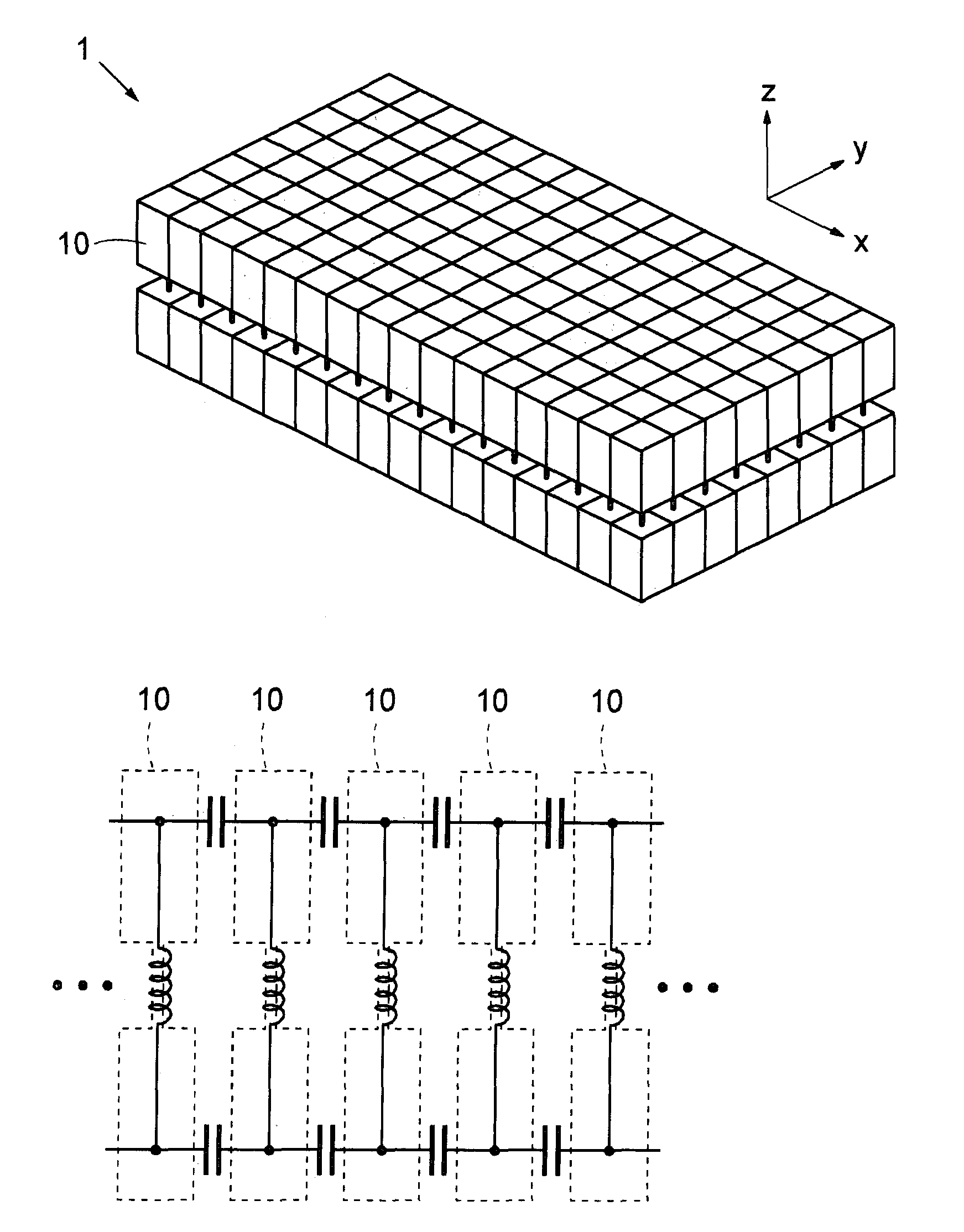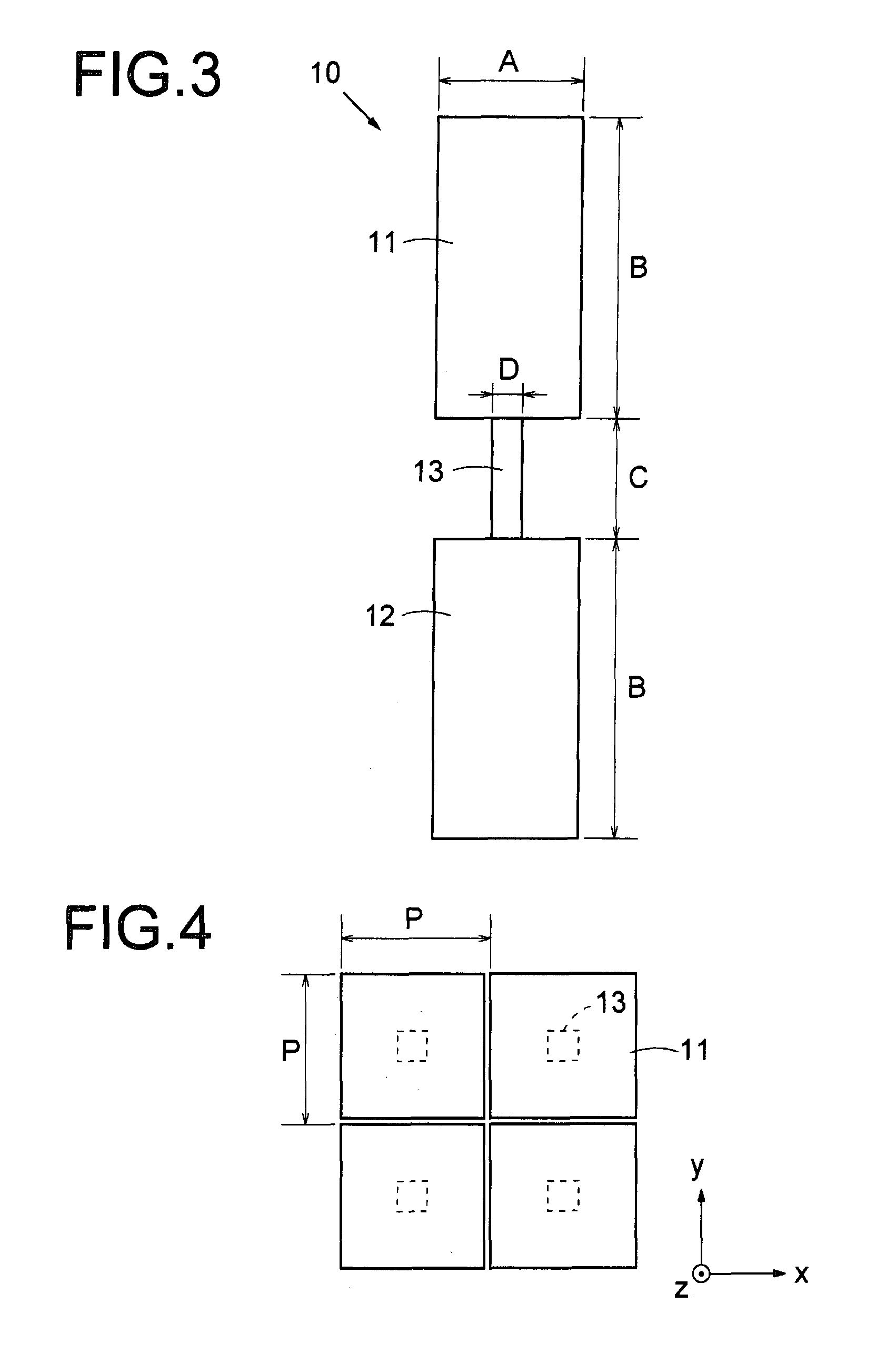Two-dimensional left-handed metamaterial
a technology of left-handed material and metamaterial, which is applied in the direction of waveguide type devices, line-transmission details, multiple-port networks, etc., can solve the problem of narrow frequency bandwidth in which the material functions as a left-handed material, the upper limit of the operation frequency of the material, and the loss increase. , to achieve the effect of reducing the operation frequency, reducing the dimensions of the unit structure, and increasing the capacitance between adjacent unit structures
- Summary
- Abstract
- Description
- Claims
- Application Information
AI Technical Summary
Benefits of technology
Problems solved by technology
Method used
Image
Examples
first embodiment
[0039]Embodiments of the present invention will now be described with reference to the drawings. FIG. 2 is a perspective view showing a metamaterial 1 according to the present invention. A unit structure 10 constituted by a conductor (typically metal) is disposed regularly (here, periodically) on a plane (here, an xy plane). In the metamaterial 1, the unit structures 10 are arranged in a lattice form having constant vertical and horizontal intervals (constant pitch).
[0040]The respective unit structures 10 are disposed at intervals such that adjacent unit structures 10 do not contact each other. The unit structure 10 may be entirely buried in an insulator or partially fixed into position by a flat plate or the like of the insulator. In FIG. 2, only 16×8=128 unit structures 10 are shown, but in an actual metamaterial, the unit structures 10 are arranged in a larger number.
[0041]FIG. 3 is a front view showing the constitution of the unit structure 10. FIG. 4 is a plan view showing the ...
second embodiment
[0048]FIG. 7 is a plan view showing an arrangement of the unit structures 10 in a metamaterial 1a according to the present invention. The constitution of the unit structure 10 is identical to that shown in FIG. 3. In the metamaterial 1 shown in FIG. 2, the unit structures 10 are arranged in a lattice form having a constant vertical and horizontal pitch, but in the metamaterial 1a, the unit structures 10 are arranged at a ½ pitch deviation in the y axis direction in each column. The metamaterial 1a also exhibits a left-handed material characteristic with this arrangement.
[0049]Various methods of arranging the unit structures 10 may be employed in addition to the arrangements shown in FIGS. 2 and 7, but an arrangement in which anisotropy is reduced to a minimum is desirable in order to bring the metamaterial closer to an isotropic medium. Arranging the unit structures 10 regularly does not only signify a periodic arrangement at completely equal intervals, and may also include an arran...
third embodiment
[0052]FIG. 8 is a front view showing the constitution of a unit structure 20 of a metamaterial according to a FIG. 9 is a plan view of the unit structure 20, and also shows an arrangement of the unit structures 20. The unit structure 20 is formed by connecting a first prism 21 and a second prism 22 using a connecting body 23. The first prism 21, second prism 22, and connecting body 23 are formed from a conductor (typically metal). The first prism 21 is a hexagonal prism in which a cross-sectional shape on a perpendicular plane to a central axis thereof is regular hexagonal, a vertical direction of FIG. 8 serving as a central axis direction. As shown in the drawing, a distance between two parallel sides of the regular hexagonal cross-section of the first prism 21 is set as a dimension E, and the length of the first prism 21 in the central axis direction is set as a dimension F.
[0053]The second prism 22 is a hexagonal prism having an identical shape to the first prism 21, and is disp...
PUM
 Login to View More
Login to View More Abstract
Description
Claims
Application Information
 Login to View More
Login to View More - R&D
- Intellectual Property
- Life Sciences
- Materials
- Tech Scout
- Unparalleled Data Quality
- Higher Quality Content
- 60% Fewer Hallucinations
Browse by: Latest US Patents, China's latest patents, Technical Efficacy Thesaurus, Application Domain, Technology Topic, Popular Technical Reports.
© 2025 PatSnap. All rights reserved.Legal|Privacy policy|Modern Slavery Act Transparency Statement|Sitemap|About US| Contact US: help@patsnap.com



